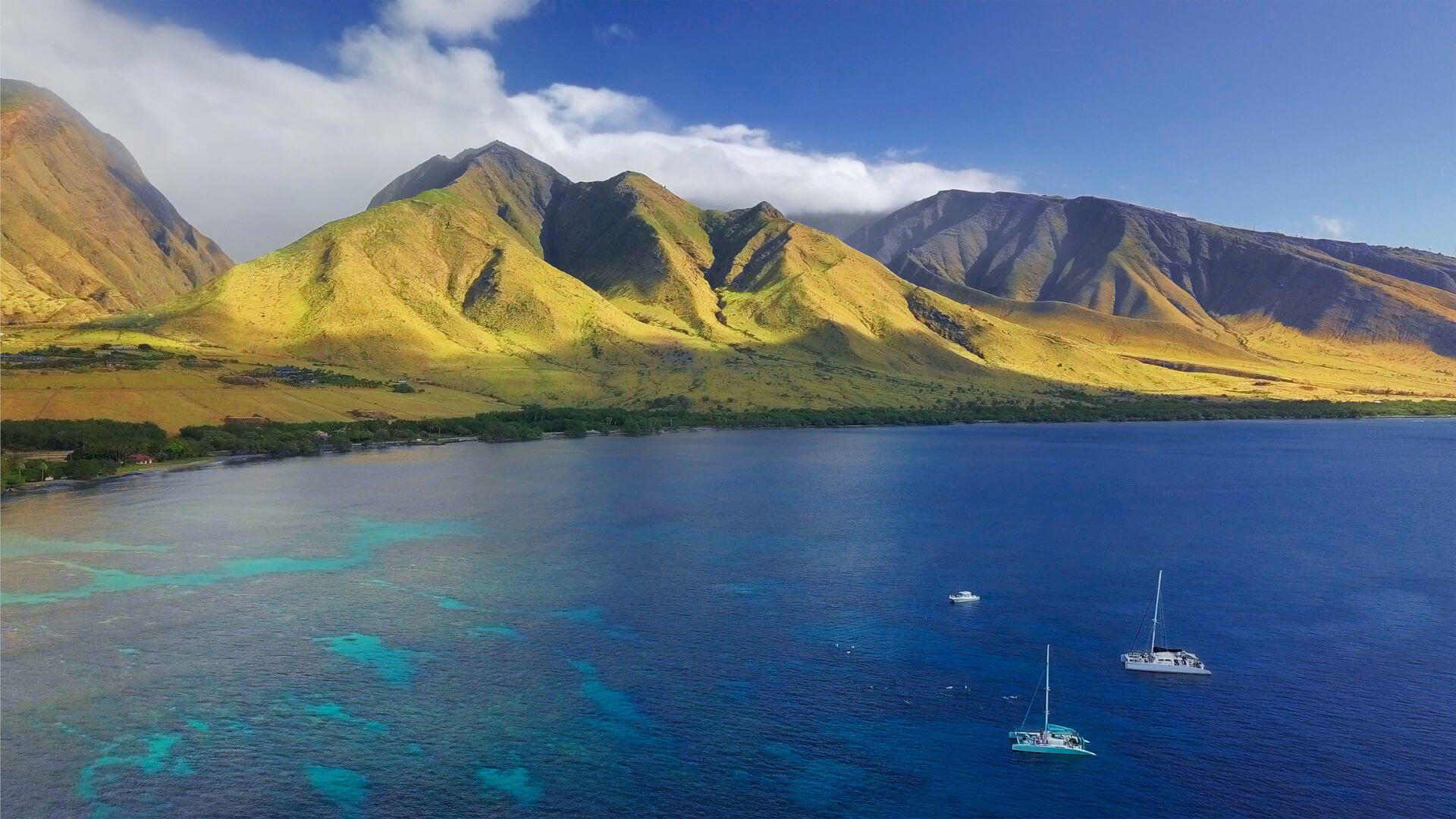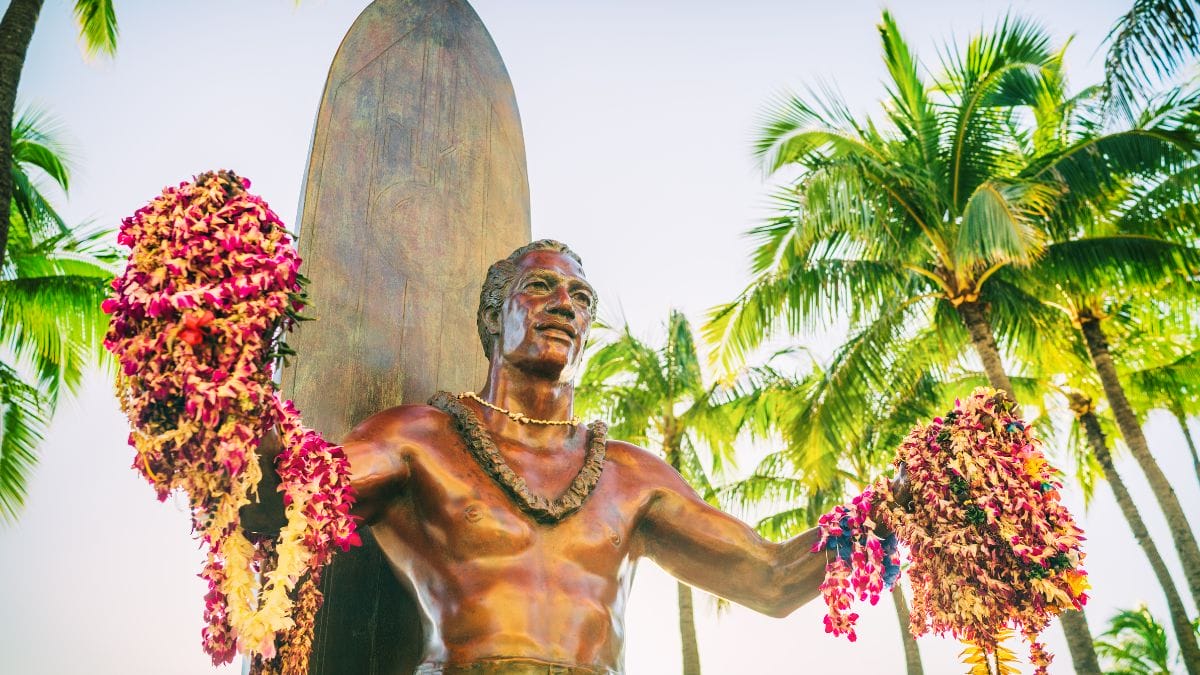Discovering the Valley Isle of Hawaii : What Island Is Maui?


Aloha! | E Komo Mai
What island is Maui? It’s Hawaii’s renowned ‘Valley Isle,’ set within the central Pacific amid the Hawaiian archipelago. Join us as we explore Maui’s varied landscapes, cultural depth, and the reasons it’s a top destination for visitors worldwide, all awaiting in the upcoming sections of this article.
Key Takeaways
- Maui, known as the Valley Isle, is the second-largest Hawaiian island with a diverse cultural and geographical landscape, shaped by two volcanoes and an isthmus, offering a distinctive experience that includes picturesque beaches and snorkeling spots like the Molokini Crater.
- The island’s rich geological history includes its origin as part of the larger Maui Nui landmass, shaped by volcanic activity, erosion, and landslides, resulting in the four current islands of Maui, Molokaʻi, Lānaʻi, and Kahoʻolawe.
- Maui’s allure is multifaceted, featuring various regions each with its own charm – the peaceful East Maui with its lush landscapes and cultural heritage, the historic and recreation-rich West Maui, and South Maui known for its luxurious resorts and beautiful beaches.

Exploring Maui's Place Among the Hawaiian Islands
Sprawled in the central part of the Hawaiian archipelago, Maui, the second-largest Hawaiian Island, presents a unique geographical profile. Unlike other islands in the chain, Maui’s landscape is shaped by two large volcanoes connected by a flat isthmus, giving it the distinctive ‘valley isle’ shape.
Maui’s idyllic charm is further amplified by its tri-island arrangement, which includes Maui itself, Lanai, and Molokai. Each of these islands offers picturesque beaches, varied terrains, and sought-after snorkeling locations such as the Molokini Crater, presenting a diverse Hawaiian experience in just one visit.
Maui’s cultural diversity distinguishes it from other Hawaiian Islands. With a demographic makeup consisting of:
- Caucasians
- Filipinos
- Japanese
- Native Hawaiians
Maui exemplifies a rich cultural tapestry. The presence of native Hawaiians, although constituting a smaller proportion of the population, adds a distinctive cultural flavor to the island.

Maui by the Numbers: Size, Population, and Tourism Stats
Having explored Maui’s captivating beauty, we now turn to a quantitative overview of the island. Maui encompasses a total land area of 727.2 square miles, providing an expansive playground for nature lovers and adventurers alike.
The island is home to approximately 165,386 residents, a testament to its warm and inviting atmosphere. But it’s not just the residents who find Maui irresistible. In 2023, the island welcomed a staggering 769,163 visitors, underlining its popularity as a world-class tourist destination.
Despite fluctuations over the past decade, Maui’s tourism numbers continue to impress, reaching a peak of 3,059,905 visitors in 2019. Although there has been a decline in visitor arrivals in recent years due to wildfires, the charm and appeal of Maui continue to attract tourists from around the world.

The Heart of Maui Nui: Understanding Maui's Geological Roots
Maui Nui, once a large island during the Pleistocene Epoch, has a fascinating geological history. Over time, a combination of landslides, erosion, and subsidence led to the fragmentation of Maui Nui into four distinct islands that we recognize today:
- Maui
- Molokaʻi
- Lānaʻi
- Kahoʻolawe
This transformation was significantly influenced by volcanic activity. In particular, the Haleakalā volcano significantly influenced Maui’s geological history, transitioning to the postshield alkalic stage of volcanism. This transition led to the distinctive geological features observed in the region today, including the breathtaking Haleakalā National Park.
This complex geological history has resulted in the formation of distinctive geological characteristics, including two shield volcanoes on the island of Maui, namely the West Maui Mountain and Haleakala. These volcanoes, along with other geographical features, contribute to the unique charm that sets Maui apart from the Big Island and other islands in the Hawaiian archipelago.

Maui's Geography: From Central Valley to Majestic Peaks
As our journey through Maui progresses, we’ll explore the island’s geography more closely, encompassing both the flat Central Valley and the majestic volcanic peaks. The different regions of Maui include:
- The Central Valley
- East Maui with its lush landscapes
- West Maui with its historical sites and beautiful beaches
- South Maui with its sun-soaked shores and luxury resorts
Together, these regions offer a diverse palette of natural beauty.
We begin this geographical exploration with East Maui, located in the vast Pacific Ocean.
East Maui: A Journey Through Lush Landscapes
Welcome to East Maui, a serene retreat from the bustling tourist hubs. This part of the island offers a peaceful escape, with historic natural sites and traditional Native Hawaiian territories. Areas such as Hana and Kipahulu are particularly renowned for their tranquil ambiance and rich cultural heritage.
The lush landscapes of East Maui, characterized by:
- dense rainforests
- abundant vegetation
- tropical hardwood trees like ‘ōhi’a and koa
- a profusion of ferns and epiphytes
are a sight to behold. The clear waters of Maui, teeming with marine life, also make it a dream destination for scuba diving enthusiasts.
One of the must-do activities in East Maui is embarking on the famous Road to Hana. Along this scenic drive, you’ll find a range of attractions such as:
- Ho’okipa Beach Park
- Twin Falls
- The scenic Huelo Lookout
- The Maui Garden of Eden
- The striking Ke’anae Peninsula
With each stop, you’ll unravel the beauty of East Maui, the second largest island in the Hawaiian archipelago.
West Maui: A Blend of History and Beachfront Bliss
Transitioning from East Maui’s lush landscapes to the western side, we encounter a contrasting aspect of Maui’s allure. West Maui, particularly the town of Lahaina, holds substantial historical importance. It served as the capital of the Hawaiian Kingdom under King Kamehaha, symbolizing its deep historical and spiritual significance for native Hawaiians. Today, it offers a variety of hiking trails, providing a delightful blend of history and natural beauty.
West Maui is also home to several museums and cultural sites, such as the Wo Hing Museum, the Baldwin Home Museum, and the Humpback National Marine Sanctuary. These establishments provide invaluable insights into the area’s rich history and heritage, serving as time capsules of Maui’s past.
For those seeking recreation, West Maui has an array of activities. Some notable attractions include:
- Visiting the Whalers Village Museum
- Hiking to Makamaka’ole Falls
- Relaxing at Puamana Park and Olowalu Turtle Reef beaches
- Whale watching, offering an encounter with Maui’s abundant marine life
There’s something for everyone in West Maui.
South Maui: Sun-Soaked Shores and World-Class Resorts
We now move on to South Maui, celebrated for its sun-drenched beaches and top-tier resorts. Stretching along the southwest coast of the island, South Maui is bordered by Haleakala to the southeast and the West Maui mountains to the northwest. Its arid and sunny weather conditions provide the perfect backdrop for a relaxing beach day or a luxury resort experience.
Among the top resorts in South Maui are the Four Seasons Resort Maui at Wailea, Hotel Wailea, and the Fairmont Kea Lani, Maui. Each offers a unique blend of luxury and island charm, providing an unforgettable Hawaiian getaway.
South Maui is also home to some of the finest beaches on the island. Here are a few of them:
- Keawakapu Beach: an intimate setting
- Ulua Beach: stunning scenery
- Makena Beach: golden sands
- Kama’ole Beach Park: ancient Hawaiian fishponds
While South Maui offers a beach experience like no other, the North Shore has its own unique charm, making it a must to visit Maui.

The Cultural Tapestry of Mau'i
While exploring Maui’s physical landscapes, let’s also immerse ourselves in the island’s culturally rich backdrop. The island’s cultural history is steeped in its early inhabitants, the Polynesian settlers, who introduced:
- a unique language
- religion
- economy
- class system
These elements laid the groundwork for Maui’s cultural foundation.
The arrival of European explorers also had a significant impact on Maui’s culture. They introduced new agricultural and aquacultural systems and brought other aspects of Western influence, such as trade and new educational and religious ideas. This blending of cultures further enriched the island’s cultural tapestry.
Missionaries, too, left a lasting impact on Maui’s culture. They propagated Christianity, founded educational institutions, and standardized a written form of the Hawaiian language. Today, some enduring Polynesian customs like the ‘honi ihu’ greeting, hula dancing, and the cultural feast known as lūʻau still thrive on the island, reflecting the rich cultural heritage of Maui.

Maui's Natural Wonders: A Guide to Parks and Protected Areas
Next, we explore the natural wonders of Maui. First on the list is the Haleakalā National Park, a testament to Maui’s extensive volcanic terrains and sub-tropical rainforests. Established in 1916, the park holds profound cultural importance for Native Hawaiians who have resided on and maintained this land for more than a thousand years.
Next, we travel to Iao Valley, renowned for its abundant greenery, imposing emerald cliffs, and notable geological formations like the 1,200-foot Iao Needle. The valley also bears historical importance as the location of the battle of Kepaniwai.
No exploration of Maui’s natural wonders would be complete without a visit to Waiʻānapanapa State Park. Its exceptional black sand beach, captivating lava formations, caves, and ancient sites provide a unique and unforgettable experience. In these parks and protected areas, you’ll find a variety of wildlife, including Humpback Whales, sea turtles, and endangered bird species, demonstrating Maui’s commitment to preserving its natural wonders.

Adventure Awaits: Top Activities for Visitors on Maui
Adventurers will find Maui teeming with exciting activities, including scenic drives along the Road to Hana, exploring the Haleakalā Crater, or relaxing on the beaches of Kaanapali. The Road to Hana offers an indelible experience with picturesque stops at Fruit Stands, historic Bridge Crossings, Twin Falls, and the scenic Huelo Lookout, to name a few.
For hiking enthusiasts, Haleakalā Crater provides exceptional trails like Waimoku Falls via Pipiwai Trail and the Pipiwai Trail, each presenting a unique journey through Maui’s striking terrains.
If you’re more inclined towards beach activities, the beaches of Kaanapali are a must-visit. From the beautiful sands of Ka’anapali Beach to the tranquil waters of Napili Bay, these beaches offer a variety of water activities and a chance to bask in the Hawaiian sun.

Living the Island Life: Insights into Maui's Communities
In addition to its natural and cultural treasures, Maui provides insights into island life with its lively communities. The bustling hub of Kahului, the largest census-designated place on Maui, functions as the island’s primary commercial and financial center.
Venturing from the bustling hub of Kahului to the laid-back charm of Paia, we encounter a different face of Maui. Paia embodies a relaxed and off-grid lifestyle, renowned for its abundant natural surroundings and unhurried rhythm. The town offers a distinctive form of opulence through its emphasis on health-conscious activities like yoga, offering a reprieve from the daily bustle.
The upcountry towns in Maui offer their own unique charm. They feature:
- Charming shops
- Boutiques
- Art galleries
- Distinctive restaurants
- Cafes
Accompanied by a cooler and more temperate climate, these towns provide a delightful juxtaposition to the coastal areas and contribute to the island’s allure.

Conclusion:
We’ve journeyed through the unique landscapes of Maui, delved into its rich cultural tapestry, ventured into its natural wonders, and explored its vibrant communities. Throughout this journey, it’s clear that Maui offers an exceptional blend of natural beauty, cultural richness, and diverse attractions, making it a memorable destination for any traveler. Whether you’re seeking adventure, relaxation, cultural immersion, or simply the allure of island life, Maui awaits with open arms.
Frequently Asked Questions
How long does it take to drive around Maui?
It takes about 9 hours to drive around Maui, not including stops. However, most visitors take their time and don’t complete the drive in one day.
How big is Maui compared to a US state?
Maui is approximately the size of Rhode Island, with a land area of 735 square miles. It is the second largest island in the Hawaiian archipelago.
Does Maui have a big city?
Yes, Kahului is the largest city in Maui, serving as the island’s commercial and financial hub, with a population of 28,219 as of 2020, and it is home to a main airport and large malls.
What is the current population of Maui?
Aloha! As of 2024, the population of Maui, the beloved Valley Isle, is approximately 166,000 people. This vibrant community is ever-growing, each new resident adding their own unique thread to the diverse and colorful tapestry that is our island home.
How many miles long and wide is Maui?
Maui is 48 miles long and 26 miles wide, with a land area of 735 square miles. This makes it the second largest island in the Hawaiian archipelago.
Share:

